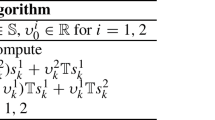Abstract.
Discrete-time coupled algebraic Riccati equations that arise in quadratic optimal control and H ∞-control of Markovian jump linear systems are considered. First, the equations that arise from the quadratic optimal control problem are studied. The matrix cost is only assumed to be hermitian. Conditions for the existence of the maximal hermitian solution are derived in terms of the concept of mean square stabilizability and a convex set not being empty. A connection with convex optimization is established, leading to a numerical algorithm. A necessary and sufficient condition for the existence of a stabilizing solution (in the mean square sense) is derived. Sufficient conditions in terms of the usual observability and detectability tests for linear systems are also obtained. Finally, the coupled algebraic Riccati equations that arise from the H ∞-control of discrete-time Markovian jump linear systems are analyzed. An algorithm for deriving a stabilizing solution, if it exists, is obtained. These results generalize and unify several previous ones presented in the literature of discrete-time coupled Riccati equations of Markovian jump linear systems.
Similar content being viewed by others
Author information
Authors and Affiliations
Additional information
Date received: November 14, 1996. Date revised: January 12, 1999.
Rights and permissions
About this article
Cite this article
Costa, O., Marques, R. Maximal and Stabilizing Hermitian Solutions for Discrete-Time Coupled Algebraic Riccati Equations. Math. Control Signals Systems 12, 167–195 (1999). https://doi.org/10.1007/PL00009849
Issue Date:
DOI: https://doi.org/10.1007/PL00009849



